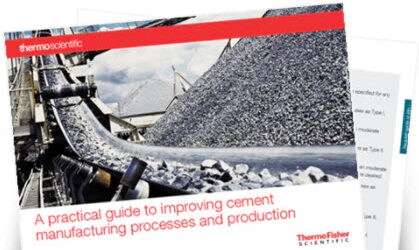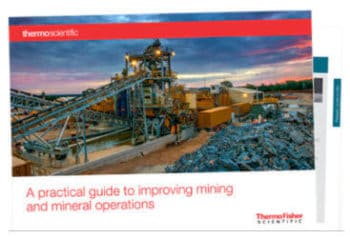X-ray fluorescence (XRF) is a non-destructive analytical technique used to determine the elemental composition of materials. XRF analyzers determine the chemistry of a sample by measuring the fluorescent (or secondary) X-ray emitted from a sample when it is excited by a primary X-ray source. Each of the elements present in a sample produces a set of characteristic fluorescent X-rays that is unique for that specific element. XRF analyzers are available in handheld models designed to provide instant elemental analysis for immediate feedback in the field, or in lab-based systems designed to provide qualitative and quantitative analysis for process and quality control.
Both types of XRF equipment are used in applications as diverse as cement manufacturing, metallurgy, mining, petroleum, polymers, paints and chemicals, forensics investigations, and environmental analysis. XRF analysis determines the elemental composition of a sample but does not provide information about how the various elements are combined together. Such mineralogical information is only available through X-ray diffraction (XRD). XRD is a versatile and nondestructive analytical technique that reveals detailed structural and chemical information about the crystallography of materials. XRD looks at a crystalline material’s characteristic X-ray scattering, or diffraction pattern, which reveals the material’s atomic structure. Qualitative analysis is possible by comparing the XRD pattern of an unknown material with a library of known patterns.
XRD’s many applications include:
- Identification of single or multiple phases in an unknown sample
- Quantification of known phases of a mixture
- Amorphous content evaluation
- Crystallography – solving crystal structure
- Non ambient analysis – crystal structure changes with temperature, pressure or gas phase
- Surface and thin film analysis
- Texture analysis
XRD can be considered complementary to XRF
Although its principles are different, XRD can be considered complementary to XRF. In a typical crystalline sample, XRF might measure for example the total calcium (Ca) concentration or the total iron (Fe) concentration. XRD permits analysis of the phases or compounds in crystalline materials such as rocks, minerals and oxide materials and products. So in the same sample, XRD takes the analysis a stage further and gives information about CaO, CaCO3 , Ca(OH)2 contents and other Ca phases or the levels of Fe phases, such as FeO, Fe2 O3 , Fe3 O4 , Fe3 C and other Fe phases. Therefore combining the results of both XRF and XRD techniques allows for a better and more complete characterization of any given crystalline sample.
Undertaking both types of analysis has traditionally called for two separate X-ray instruments, maintained and operated at significant cost to the user. But the integration of innovative X-ray diffraction systems allows both techniques to be included in the same instrument, bringing significant advantages to the user.
- Only one sample introduction
- Single user interface for both techniques
- Elemental and phase results merged into one single analysis bulletin
- Minimized floor space
- No water cooler at mid power levels.
Combined XRF-XRD instrumentation has many useful applications including analysis of:
- Elemental analysis in all types of materials
- Free lime in clinker and in slags
- Clinker phases
- Fe2+ determination in sinters
- Iron phases in DRI (Direct Reduced Iron) processes
- Phases related to electrolysis of aluminum.
To learn about other analytical technologies particularly useful in the metals and mining industries, read the following Analyzing Metals and Advancing Mining blog posts:
- Technology Focus: X-ray Fluorescence (XRF) in Mining
- Technology Focus: Silicon Drift Detectors
- Technology Focus: Optical Emission Spectrometry for Alloying and Trace Elements in Metals
- Technology Focus: X-Ray Photoelectron Spectroscopy (XPS)
Editor’s Note: This article was originally published in June 2015 but has been refreshed and broken links fixed.







Request for more technical details on combined XRF XRD instrument and its application in mineral analysis for Petroelum and mining industry .
Arun — We have plenty of information on XRF XRD instruments and applications. Visit this page: http://www.thermofisher.com/us/en/home/industrial/spectroscopy-elemental-isotope-analysis/oes-xrd-xrf-analysis.html
You may be interested in watching this technical webinar: Advanced Applications in Geochemistry and Mining Analysis
It’s hard to find well-informed people about this topic, but you sound like you know what
you’re talking about! Thanks